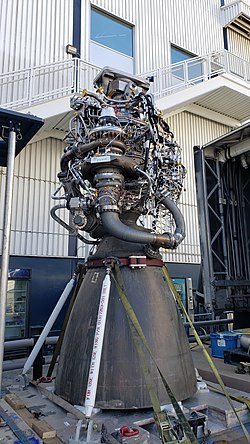SpaceX Raptor
 Raptor di fasilitas produksi SpaceX di Hawthorne | |
| Negara asal | Amerika Serikat |
|---|---|
| Pembuat | SpaceX |
| Penggunaan | Propulsi tingkatan pertama dan kedua bagi kendaraan peluncur Starship |
| Status | Dalam pengembangan |
| cair | |
| Konfigurasi | |
| Ruang | 1 |
| Rasio pipa | 40 |
| Kinerja | |
| Daya dorong | max 2.210 kN; 500.000 lbf (225 tf)[1] min 880 kN; 200.000 lbf (90 tf)[2] |
| Thrust-to-weight ratio | 200 (target)[3] <120 (vac)[4] |
| Tekanan ruang | 300 bar (30 MPa; 4.400 psi)[5][6] 330 bar (33 MPa; 4.800 psi)[1] (~ 7s test) |
| Isp (vac.) | 380 s (3.700 m/s) (goal)[5] |
| Isp (SL) | 330 s (3.200 m/s)[5] |
| Dimensi | |
| Panjang | 31 m (102 ft)[7] |
| Diameter | 13 m (43 ft)[8] |
| Berat kering | 1.500 kg (3.300 pon) (target)[4] |
| Digunakan pada | |
| Starship | |
SpaceX Raptor adalah sebuah mesin dengan siklus full-flow staged combustion berbahan bakar metana yang diproduksi oleh SpaceX. Mesin ini ditenagai oleh metana cair kriogenik dan oksigen cair (LOX), berbeda dengan mesin SpaceX sebelumnya (Merlin dan Kestrel) yang menggunakan RP-1 kerosin dan LOX. Awalnya, Raptor dikonsepkan sebagai mesin berbahan bakar hidrogen cair (LH
2).[9] Mesin raptor mampu menghasilkan gaya dorong dua kali lebih kuat dibandingkan mesin Merlin 1D yang saat ini mentenagai roket Falcon 9.
Raptor akan digunakan dalam sistem Starship, roket dua-tingkat-ke-orbit dengan daya angkat super berat.[10][11] Sistem peluncur tersebut rencananya akan menggantikan semua kendaraan SpaceX saat ini, termasuk roket Falcon 9 dan Falcon Heavy dan wahana antariksa SpaceX Dragon 2.[12] Sebagai bagian dari Starship, Raptor akan digunakan dalam berbagai aplikasi, seperti meluncurkan satelit menuju orbit Bumi, meluncurkan megakonstelasi satelit internet Starlink, dan kolonisasi Mars.[13]
Mesin Raptor memulai uji terbang pada roket purwarupa Starhopper pada Juli 2019 dan menjadi mesin roket dengan siklus pembakaran full-flow staged combustion pertama yang berhasil diterbangkan.[14] Hingga Januari 2020, Raptor memegang rekor tekanan terbesar pada ruang pembakaran mesin roket operasional, sebesar 330 bar (33,000 kilopascals), mengalahkan rekor sebelumnya yang dipegang oleh mesin RD-701 pada tekanan 300 bar.[15][16]
Referensi
- ^ a b @elonmusk (17 August 2020). "Raptor engine just reached 330 bar chamber pressure without exploding! ... SN40 ... has several upgrades over 330 bar engine. For reference, 330 bar on Raptor produces ~225 tons (half a million pounds) of force" (Tweet) – via Twitter.
- ^ @elonmusk (17 August 2020). "Max demonstrated Raptor thrust is ~225 tons & min is ~90 tons, so they're actually quite similar. Both Merlin & Raptor could throttle way lower with added design complexity" (Tweet) – via Twitter.
- ^ Michael Sheetz on Twitter: Musk goes into a long explanation of the potential capabilities of the SpaceX Raptor rocket engine (which will power Starship), saying that the company thinks Raptor could achieve a thrust-to-weight ratio of 200.
- ^ a b Elon Musk on Twitter: Max thrust version of Raptor should achieve true T/W > 170. Target is 1.5 ton engine with >260 t-F. Max Isp version should achieve ~380 sec, but T/W probably <120 due to big nozzle. These are just guesses for now.
- ^ a b c Musk, Elon (17 September 2018). "First Lunar BFR Mission". YouTube. Berlangsung pada 45:30.
And this is the Raptor engine that will power BFR both the ship and the booster, it’s the same engine. And this is approximately a 200-ton thrust engine that’s aiming for roughly a 300-bar or 300-atmosphere chamber pressure. And if you have it at a high expansion ratio it has the potential to have a specific impulse of 380.
- ^ Elon Musk on Twitter:Reaching chamber pressure of 300 atmospheres
- ^ https://www.spacex.com/starship
- ^ Musk, Elon (29 September 2017). "Making Life Multiplanetary". youtube.com. SpaceX. Diakses tanggal 29 September 2017.
- ^ Markusic, Tom (28 July 2010). SpaceX Propulsion (PDF). 46th AIAA/ASME/SAE/ASEE Joint Propulsion Conference. hlm. 12–15. Diakses tanggal 28 October 2015.
- ^ "Starship Users Guide, Revision 1.0, March 2020" (PDF). SpaceX/files. SpaceX. March 2020. Diarsipkan dari versi asli (PDF) tanggal 2 April 2020. Diakses tanggal 18 May 2020.
SpaceX's Starship system represents a fully reusable transportation system designed to service Earth orbit needs as well as missions to the Moon and Mars. This two-stage vehicle — composed of the Super Heavy rocket (booster) and Starship (spacecraft)
- ^ Grush, Loren (28 September 2017). "What to expect from Elon Musk's Mars colonization update this week". The Verge.
- ^ Gebhardt, Chris (29 September 2017). "The Moon, Mars, & around the Earth – Musk updates BFR architecture, plans". NASASpaceflight.com. Diarsipkan dari versi asli tanggal 1 October 2017. Diakses tanggal 2 October 2017.
In a move that would have seemed crazy a few years ago, Mr. Musk stated that the goal of BFR is to make the Falcon 9 and the Falcon Heavy rockets and their crew/uncrewed Dragon spacecrafts redundant, thereby allowing the company to shift all resources and funding allocations from those vehicles to BFR. Making the Falcon 9, Falcon Heavy, and Dragon redundant would also allow BFR to perform the same Low Earth Orbit (LEO) and Beyond LEO satellite deployment missions as Falcon 9 and Falcon Heavy – just on a more economical scale as multiple satellites would be able to launch at the same time and on the same rocket thanks to BFR's immense size.
- ^ Leone, Dan (25 October 2013). "SpaceX Could Begin Testing Methane-fueled Engine at Stennis Next Year". Space News. Diakses tanggal 26 October 2013.
- ^ Burghardt, Thomas (25 July 2019). "Starhopper successfully conducts debut Boca Chica Hop". NASASpaceFlight.com. Diakses tanggal 26 July 2019.
- ^ Ralph, Eric. "News SpaceX crushes rocket engine world record during Raptor test". Teslarati. Diakses tanggal 19 August 2020.
- ^ Tangermann, Victor. "SpaceX Tests Highest Pressure Rocket Engine In History". Futurism. Diakses tanggal 19 August 2020.
